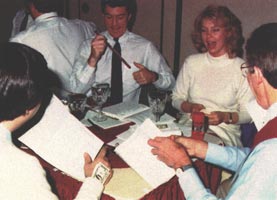
Brain Power
Training For Tomorrow - September 1998 - Human Resource ExecutiveHerrmann International helps National Semiconductor build communication skills among technologists.
In the early 1990s, National Semiconductor in Santa Clara, Calif., radically changed the way some of its employees thought, learned and communicated.
This was done to meet the demands of a hard-nosed business strategy that was introduced in 1991 by Gil Amelio, the company's new chief executive officer. Up to that point, the organization had produced a high volume of "jelly beans" or low-value commodities and became well-known for its manufacturing ability.
But that scenario was about to change. Instead of focusing on manufacturing commodities, the company would begin developing value-added mixed signal products that combined analog and digital technology.
In order to facilitate the switch, Amelio realized the company needed to move its efforts away from manufacturing toward product development and leadership. And that's where the problem began.
"It was a manufacturing driven organization for so many years and now manufacturing had to step out of the limelight," explains Paul Gustavson, whose San Jose, Calif., consulting firm, Organization Planning and Design Inc., was working with the company at the time.
"It became very clear to Gil and others that they had to build the self-esteem of its product designers and figure out a way for people in different disciplines to share ideas with one another to produce great products."
But how do you build self-esteem of its product designers and figure out a way for people in different disciplines to share ideas with one another to produce great products."
But how do you build self-esteem and communication skills among technologists who are notorious for being loners and have a propensity to focus only on their specific product area?
To achieve the dream of being the world's best manufacturer, workers at this facility spend time learning about all the steps in the creation of their product. Gustavson pointed National in the direction of Herrmann International, a firm that measures and builds brain power within companies. The Lake Lure, N.C., organization was founded by Ned Herrmann, and his daughter, Ann Herrmann-Nehdi, is CEO. The firm, whose mantra is "putting a company's whole brain to work," helps employees understand their own and other people's thinking styles to unlock creativity and enhance productivity.
As part of National's transformation, Gustavson and Herrmann International prepared a one-day seminar in 1994 for the company's key 50 technologists. They represented different product lines, and this was the first time they had gathered as a group.
The seminar's focus was threefold: to develop a sense of pride among participants about their work contributions, introduce a new way of thinking and communicating and help the company attract and retain top technical talent.
To demonstrate that the company was serious about changing its direction and image, every senior officer at National attended the workshop, which was held at a very prestigious hotel.
"The old culture at National was so cost-conscious that there was even a joke going around that the company owned a goat that ate the grass out in front of the building," recalls Gustavson. He says that by sponsoring a first-class seminar, even the most skeptical of technologists began to feel "special".
During the workshop, technologists used the Herrmann Brain Dominance Instrument to assess their thinking styles. The 120-question tool identifies four different management styles:
- Logical, analytical, technical and often bottom-line tough. Decisions are based on facts.
- Very detailed, structured and solid, down-to-earth with no equivocation and ambiguity. Activities are performed on time and according to procedure.
- Highly participatory and team-oriented. People are considered to be the most important asset.
- Conceptual, intuitive, holistic, adventurous and risk-taking. The style is very open with very little structure.
The HBDI assessment launched a series of discussions on how the technologists processed information and could use it to become more creative, recalls Gustavson. Heterogeneous teams were then formed and guided through problem-solving processes, which unveiled the company's creative potential.
"The workshop gave them a framework so they could begin to talk to one another," says Gustavson. "One of the great things that came out of it was a notion of communities of practice."
Basically, communities of practice are each composed of a small group on people who may perform similar jobs or collaborate on a task or project.
So far, the results of the workshop have been far reaching. Today, National supports at least four communities of practice and has created a CoP council that dispenses advice ranging from technical support and helping other technologists form CoPs to encouraging CoPs to build home pages on the Web sites so they can actively share ideas with other employees.

